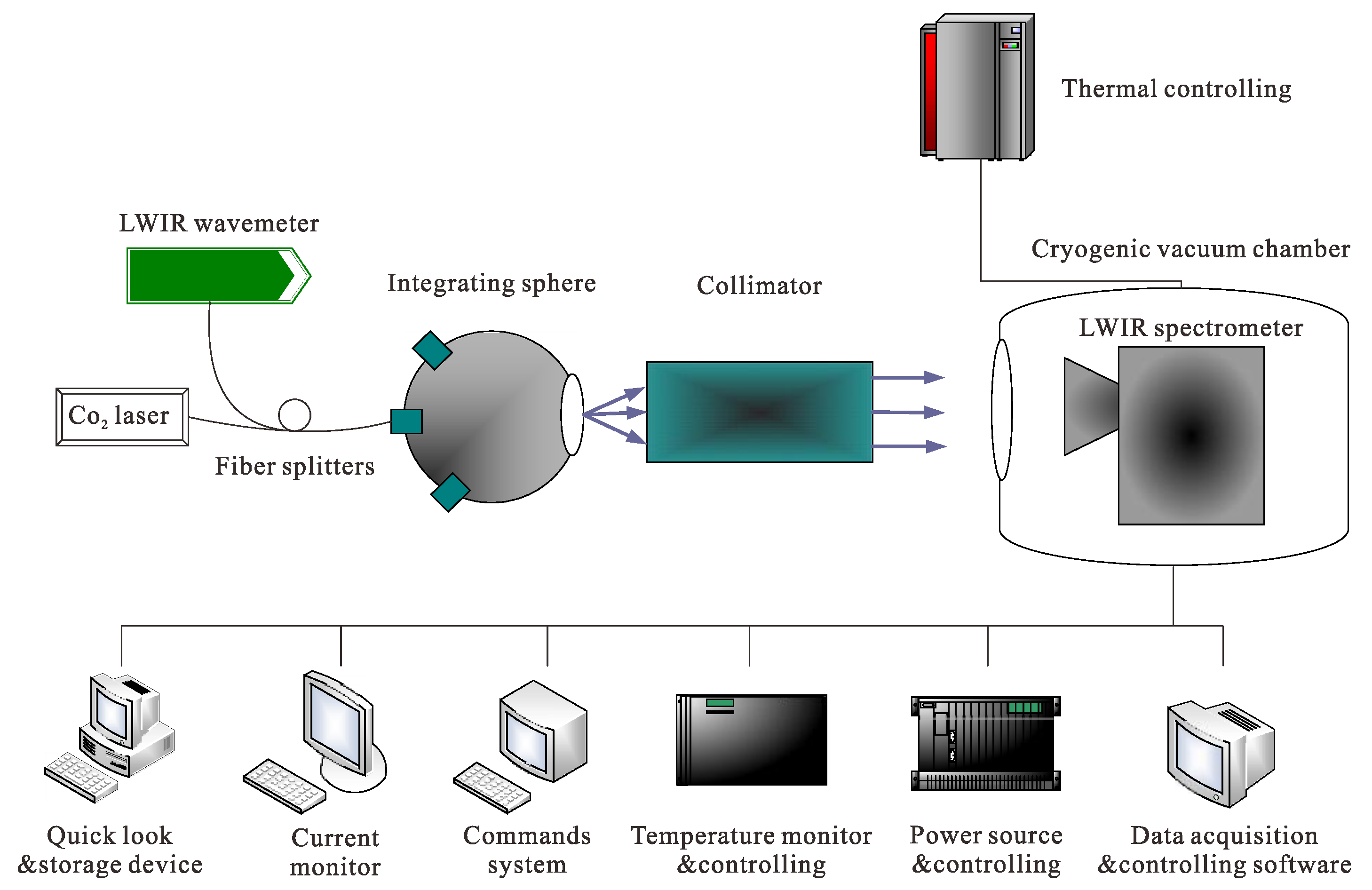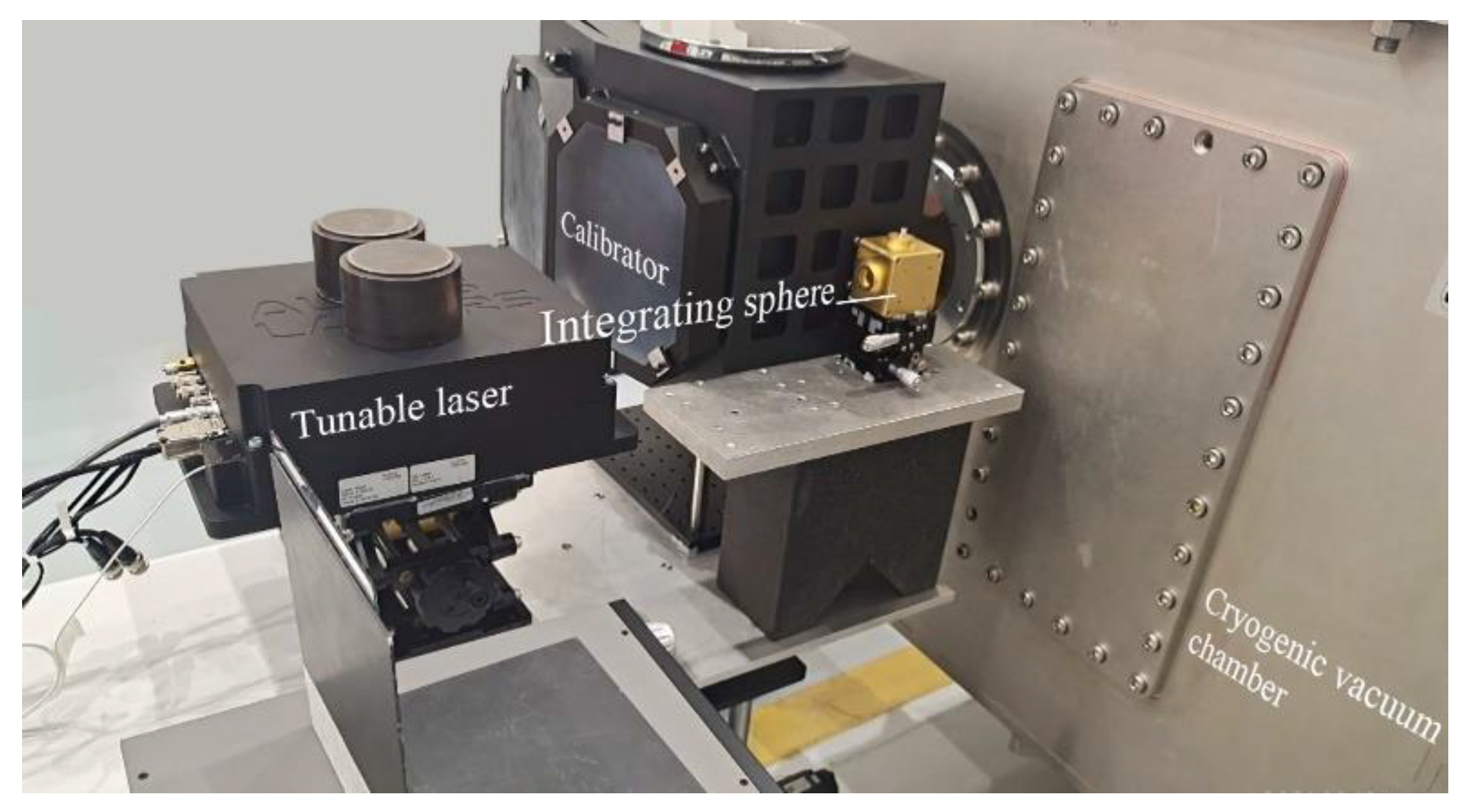Cryogenic Refocusing of an Ultrawide FOV Long-Wave Infrared Imaging Spectrometer in a Geostationary Orbit
Abstract
:1. Introduction
2. Materials and Methods
2.1. Field Stitching Method
2.2. Cryogenic Refocusing Principle
2.3. Spectral Response Function Basis
3. Imaging Spectrometer Design and Analysis
3.1. Spectrometer Technical Specifications
3.2. Ultrawide FOV Imaging Spectrometer Design
4. Experiment Results
4.1. Simulation Results of Cryogenic Refocusing
4.2. Experimental Results of Cryogenic Refocusing
4.3. Experimental Results of Laboratory Spectral Calibration
5. Discussion
6. Conclusions
Author Contributions
Funding
Data Availability Statement
Conflicts of Interest
References
- Xue, Q.; Tian, Z.; Yang, B.; Ji, Z.; Luan, X.; Mu, B.; Qiu, X. Optical System Design of Geostationary Hyperspectal Ocean Water Color Imager with Wide Coverage. Acta Photonica Sin. 2020, 49, 0501001. [Google Scholar] [CrossRef]
- Guo, L.; Deng, Z.; Tao, J.; Sun, X.; Wang, B.; Pei, S.; Liang, W.; Gu, W. Preliminary research on development of foreign GEO remote sensing satellites. Spacecr. Recovery Remote Sens. 2010, 31, 23–30. [Google Scholar] [CrossRef]
- Zhang, L.; Wang, J.; An, Z. Design of a Communication Device of Infrared Thermal Imaging Target Recognition and Tracking System. Adv. Multimed. 2022, 2022, 1995418. [Google Scholar] [CrossRef]
- Chrisp, M.P. Wide Swath Imaging Spectrometer Utilizing a Multi-Modular Design. U.S. Patent 7,808,635B2, 4 March 2010. [Google Scholar]
- Wang, J.; Li, C.; Lv, G.; Yuan, L.; Liu, E.; Jin, J.; Ji, H. Development of practical thermal infrared hyperspectral imaging system. In Proceedings of the Multispectral, Hyperspectral, and Ultraspectral Remote Sensing Technology, Techniques and Applications V, Beijing, China, 13–16 October 2014; Volume 9263, p. 92630E. [Google Scholar] [CrossRef]
- Johnson, W.R.; Hook, S.J.; Mouroulis, P.Z.; Wilson, D.W.; Gunapala, S.D.; Hill, C.J.; Mumolo, J.M.; Eng, B.T. QWEST: Quantum Well Infrared Earth Science Testbed. In Imaging Spectrometry XIII, Proceedings of the Optical Engineering + Applications, San Diego, CA, USA, 27 August 2008; SPIE: Bellingham, WA, USA, 2008; Volume 7086, p. 708606. [Google Scholar] [CrossRef]
- Shen, S.; Zhu, J.; Huang, X.; Shen, W. Suppression of the Self-Radiation Stray Light of Long-Wave Thermal Infrared Imaging Spectrometers. In Proceedings of the 5th International Symposium of Space Optical Instruments and Applications, Beijing, China, 5–7 September 2018; Volume 232, pp. 101–110. [Google Scholar] [CrossRef]
- Li, C.; Ding, Y.; Lin, C.; Wei, Y.; Zheng, Y.; Zhang, L. Optomechanical design and simulation of a cryogenic infrared spectrometer. Appl. Opt. 2020, 59, 4642–4649. [Google Scholar] [CrossRef] [PubMed]
- Hackwell, J.A.; Warren, D.W.; Bongiovi, R.P.; Hansel, S.J.; Hayhurst, T.L.; Mabry, D.J.; Sivjee, M.G.; Skinner, J.W. LWIR/MWIR imaging hyperspectral sensor for airborne and ground-based remote sensing. In Proceedings of the SPIE’s 1996 International Symposium on Optical Science, Engineering, and Instrumentation, Denver, CO, USA, 13 November 1996; Volume 2819, pp. 102–107. [Google Scholar] [CrossRef]
- Te Plate, M.; Birkmann, S.; Sirianni, M.; Rumler, P.; Jensen, P.; Ehrenwinkler, R.; Mosner, P.; Karl, H.; Rapp, R.; Wright, R.; et al. JWST’s near infrared spectrograph status and performance overview. In Proceedings of the SPIE Optical Engineering + Applications, San Diego, CA, USA, 14 September 2016; Volume 9973, p. 99730E. [Google Scholar] [CrossRef]
- Taccola, M.; Bagnasco, G.; Barho, R.; Caprini, G.C.; Giampietro, M.D.; Gaillard, L.; Mondello, G.; Salvignol, J.C.; Plate, M.T.; Tonetti, N.; et al. The cryogenic refocusing mechanism of NIRSpec opto-mechanical design, analysis, and testing. In Proceedings of the SPIE Astronomical Telescopes + Instrumentation, Marseille, France, 23 July 2008; Volume 7018, p. 70181Z. [Google Scholar] [CrossRef]
- Yuan, L.; He, Z.; Lv, G.; Wang, Y.; Li, C.; Xie, J.; Wang, J. Optical design, laboratory test, and calibration of airborne long wave infrared imaging spectrometer. Opt. Express. 2017, 25, 22440–22454. [Google Scholar] [CrossRef] [PubMed]
- Zhang, Y. Optical Technology of Long-Wave Infrared Hyperspectral Imaging; Shanghai Institute of Technical Physics: Shanghai, China, 2016. [Google Scholar]
- Duncan, B.D.; Bos, P.J.; Sergan, V. Wide-angle achromatic prism beam steering for infrared countermeasure applications. Opt. Eng. 2003, 42, 1038–1047. [Google Scholar] [CrossRef]
- Palmer, T.A.; Alexay, C.C.; Vogel, S. Somewhere under the rainbow: The visible to far infrared imaging lens. In Proceedings of the SPIE Defense, Security, and Sensing, Orlando, FL, USA, 20 May 2011; Volume 8012, p. 801223. [Google Scholar] [CrossRef]
- Kruse, F.A.; McDowell, M. Analysis of multispectral and hyperspectral longwave infrared (LWIR) data for geologic mapping. In Proceedings of the Algorithms and Technologies for Multispectral, Hyperspectral, and Ultraspectral Imagery XXI, Baltimore, MD, USA, 21 May 2015; Volume 9472, p. 94721E. [Google Scholar] [CrossRef]
- Hall, J.L.; Boucher, R.H.; Buckland, K.N.; Gutierrez, D.J.; Hackwell, J.A.; Johnson, B.R.; Keim, E.R.; Moreno, N.M.; Ramsey, M.S.; Sivjee, M.G.; et al. MAGI: A new high-performance airborne thermal-infrared imaging spectrometer for earth science applications. IEEE Trans. Geosci. Remote Sens. 2015, 53, 5447–5457. [Google Scholar] [CrossRef]
- Notesco, G.; Weksler, S.; Ben-Dor, E. Application of Hyperspectral Remote Sensing in the Longwave Infrared Region to Assess the Influence of Dust from the Desert on Soil Surface Mineralogy. Remote Sens. 2020, 12, 1388. [Google Scholar] [CrossRef]
- Zare, A.; Bolton, J.; Gader, P.; Schatten, M. Vegetation Mapping for Landmine Detection Using Long-Wave Hyperspectral Imagery. IEEE Trans. Geosci. Remote Sens. 2008, 46, 172–178. [Google Scholar] [CrossRef]
- Zhang, J.; Zheng, Y.; Lin, C.; Ji, Z.; Wu, H. Analysis method of the Offner hyperspectral imaging spectrometer based on vector aberration theory. Appl. Opt. 2021, 60, 264–275. [Google Scholar] [CrossRef] [PubMed]
- Montero-Orille, C.; Prieto-Blanco, X.; González-Núñez, H.; Fuente, R.d.l. Design of Dyson imaging spectrometers based on the Rowland circle concept. Appl. Opt. 2011, 50, 6487–6494. [Google Scholar] [CrossRef] [PubMed]
- Content, R.; Sharples, R.M.; Blake, S.; Talbot, R.G. EUCLID: Design of the prism DMD NIR spectrograph. In Proceedings of the SPIE Astronomical Telescopes + Instrumentation, San Diego, CA, USA, 10 August 2010; Volume 7731, p. 77312Y. [Google Scholar] [CrossRef]
- FÉRY, C. A prism with curved faces, for spectrograph or spectroscope. Astrophys. J. 1911, 34, 79–87. [Google Scholar] [CrossRef]
- Wang, J. Analysis about Spectral Resolving Power of Imaging Spectrometer. Chin. J. Infrared Res. 1990, 9, 277–286. [Google Scholar]
- Gao, Z.; Jia, R.; Zhang, H.; Xia, Z.; Fang, W. Simulation and Analysis of Spectral Response Function and Bandwidth of Spectrometer. Int. J. Aerospace. Eng. 2016, 2016, 2759121. [Google Scholar] [CrossRef] [Green Version]
- Zemax (An Ansys Company); OpticsAcademy (Optics Studio). Available online: https://www.zemax.com (accessed on 1 August 2022).
- Zheng, Y. Precise spectral calibration for hyperspectral imager. Opt. Precision Eng. 2010, 18, 2347–2354. [Google Scholar]
- Zadnik, J.; Guerin, D.; Moss, R.; Orbeta, A.; Dixon, R.; Simi, C.G.; Dunbar, S.; Hill, A. Calibration procedures and measurements for the COMPASS hyperspectral imager. In Proceedings of the Defense and Security, Orlando, FL, USA, 12 August 2004; Volume 55425, pp. 182–1188. [Google Scholar] [CrossRef]






















| Parameter | Value |
|---|---|
| Spectral ranges | 8~12.5 μm |
| Numerical aperture | 0.0923 |
| Slit length | 120 mm |
| Spectral resolution | <120 nm |
| Dispersion width | 3.75 mm |
| Pixel size | 30 μm × 30 μm |
| Pixel array | 320 × 256 |
| Surface | Radius/mm | Distance/mm | Tilt/° |
|---|---|---|---|
| Primary mirror | −776.45 | 764.86 | −7.6315 |
| Curved prism (front surface) | −411.57 | −374.42 | −16.446 |
| Curved prism (back surface) | −399.903 | 3.13 | −11.9203 |
| Triple mirror | −776.45 | 375.21 | −7.2913 |
Publisher’s Note: MDPI stays neutral with regard to jurisdictional claims in published maps and institutional affiliations. |
© 2022 by the authors. Licensee MDPI, Basel, Switzerland. This article is an open access article distributed under the terms and conditions of the Creative Commons Attribution (CC BY) license (https://creativecommons.org/licenses/by/4.0/).
Share and Cite
Han, Y.; Zheng, Y.; Lin, C.; Ji, Z.; Xue, H.; Li, C.; Zhang, J.; Shi, Y.; Gao, Q. Cryogenic Refocusing of an Ultrawide FOV Long-Wave Infrared Imaging Spectrometer in a Geostationary Orbit. Remote Sens. 2022, 14, 5799. https://doi.org/10.3390/rs14225799
Han Y, Zheng Y, Lin C, Ji Z, Xue H, Li C, Zhang J, Shi Y, Gao Q. Cryogenic Refocusing of an Ultrawide FOV Long-Wave Infrared Imaging Spectrometer in a Geostationary Orbit. Remote Sensing. 2022; 14(22):5799. https://doi.org/10.3390/rs14225799
Chicago/Turabian StyleHan, Yanxue, Yuquan Zheng, Chao Lin, Zhenhua Ji, Hao Xue, Chengliang Li, Jialun Zhang, Yi Shi, and Quyouyang Gao. 2022. "Cryogenic Refocusing of an Ultrawide FOV Long-Wave Infrared Imaging Spectrometer in a Geostationary Orbit" Remote Sensing 14, no. 22: 5799. https://doi.org/10.3390/rs14225799
APA StyleHan, Y., Zheng, Y., Lin, C., Ji, Z., Xue, H., Li, C., Zhang, J., Shi, Y., & Gao, Q. (2022). Cryogenic Refocusing of an Ultrawide FOV Long-Wave Infrared Imaging Spectrometer in a Geostationary Orbit. Remote Sensing, 14(22), 5799. https://doi.org/10.3390/rs14225799





